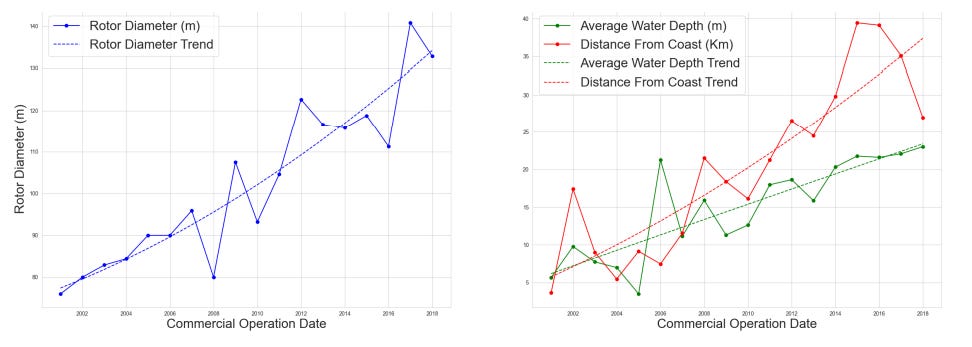For decades, the trend in offshore wind farms was to build larger towers with larger blades at increasing distance from the shore. This tends to make offshore wind more economical and reduce intermittency issues from low wind. But researchers from INSEAD claim we have gone too far.
The idea of offshore wind is simple. You can build much larger windmills that have larger blades and generate more electricity, without disturbing local (air) traffic, spoiling the environment or endangering wildlife.
At the same time wind tends to be stronger and more reliable further offshore than on land or close to the beach. Hence, the maths seemed simple. Build the largest windmills as far offshore as possible. This may cost more to install, but over the life of a windfarm this will be worth it given the higher revenues. Today, offshore windfarms sport windmills with average rotor diameters of 130m to 140m and are installed some 30km to 40km away from land.
Offshore windfarms use larger windmills farther away from the shore
Source: Fraunhofer Institute for Energy Economics (2019)
But is this ‘bigger is better’ motto really working? After all, larger windmills further offshore cost more to maintain and have higher costs at the end of their life as operators have to deinstall the towers. As inflation and wage costs have risen in recent years, major operators of offshore wind like Oersted have cancelled projects or are considering scaling them down too keep them economically viable.
When offshore wind farms were new, nobody really had any idea how much it would cost to maintain or decommission them. As we gain more experience with maintenance costs and decommissioning, it becomes increasingly clear that bigger isn’t always better for offshore wind. Below are estimates for the optimal blade size and distance from shore for offshore wind farms based on real-life maintenance and end-of-life costs (MEOL).
Optimal blade size and distance from shore
Source: Aflaki et al. (2024)
Looking at the estimates it seems we are coming close to the optimal blade size since the average rotor diameter of 140m implies a blade size of roughly 70m. And lifetime value of a windmill plateaus for blade sizes of 70-80m. However, this assumes that the windfarm is installed more than 30km offshore. For windfarms installed closer to shore, blade sizes of 40-60m are optimal and larger blades aren’t working efficiently enough and cost too much in maintenance.
All of this shows that companies like Vestas Wind Systems, Siemens Energy, and General Electric have to make a strategic decision. Should they develop larger wind turbines that can be installed further offshore where margins are higher, but demand may be limited due to the difficulty of making such windfarms profitable? Or should they focus more on smaller wind turbines that are installed closer to shore, where margins are lower, but volumes are higher? Just like with any high-tech product, I think the market will bifurcate into mass market producers and cutting edge-high tech producers in coming years. And where each company decides to position its business will determine its share price and its future growth.






An other risk that seems to materialize is when they implode because of tempest they release a fulload of fiberglass in imploding. Class action could be monstruous if it happens to often
Just build nuclear plants ffs